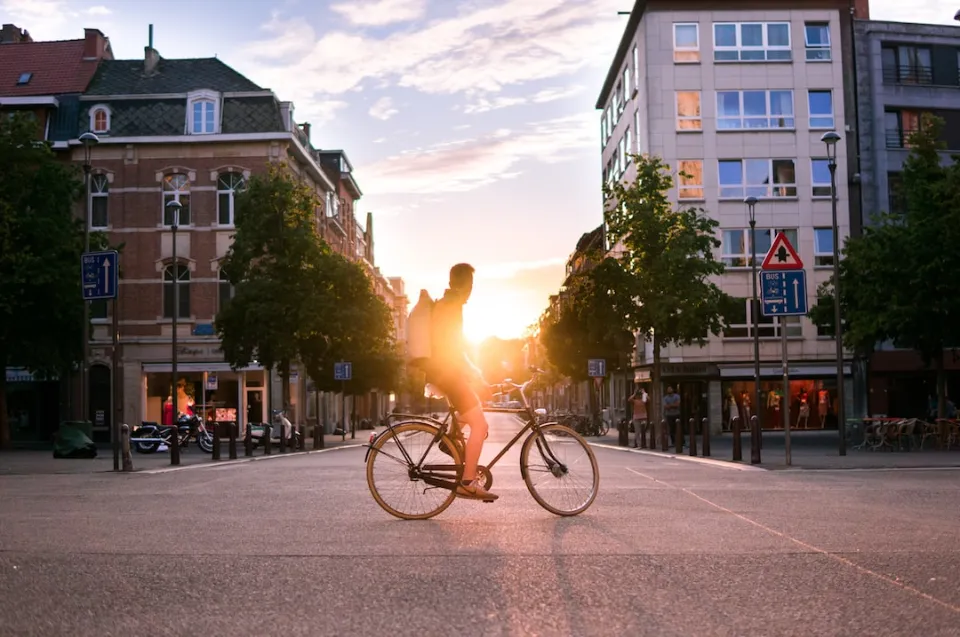There are many reasons bicyclists ask, “is it illegal to cycle without a helmet?” Even though it is not against the law to cycle without a helmet and even though you may have your own justifications for doing so, we strongly advise against it.
We know firsthand the value of helmets for cycling safety because we are both avid cyclists. Wearing a helmet to protect your head and neck is always a good idea whether you are riding a unicycle, bicycle, motorcycle, or anything else.
In this article, we will dive into guidelines surrounding bike safety and how helmets work. We will conclude by arguing that wearing a helmet is always a good idea, ending your need to ever consider this issue. After reading, we hope you will join us in supporting helmet safety!
Table of Contents
Bicycle Safety
The National Highway Traffic Safety Administration (NHTSA) is part of the United States Department of Transportation, focused on all of the vehicles that travel across our big nation. This agency also promotes bicycle safety to make roads safe for everyone.
More people are choosing to bike everywhere, including to work or school, each year. Even standard and electric bikes are readily available for rent on the streets in many cities. The rise in bicycle traffic is a result of environmental and health-related trends.
The NHTSA reports that in 2019, there were 846 bicycle fatalities and 49,000 bicycle-related injuries. Knowing bicycle safety is more important than ever because of the rise in bicycle traffic as well as the inescapable accidents that happen.
Bicycles have the same rights as other vehicles, like cars or buses, when they are on the road. It is understood that bicyclists and other motor vehicles will share the road and abide by all traffic regulations.

Common Laws
Several traffic laws that apply to other vehicles and bicycles have similarities. There may be local bicycle laws in your area that are enforced at the state and local levels. Be sure to review the specific rules that apply to the roads you plan to travel.
Currently, there is no common law that mandates bicycle helmet use. However, there are numerous local and state laws that specifically address bicycle helmets, which we will cover in the following section.
Signaling
Bicyclists must inform other vehicles of their intention to turn, stop, or change lanes. Similar to a car, some bikes have turn signals attached. However, if yours does not, you can still cycle safely and keep from getting a traffic ticket by using a few simple hand signals.
- Right turn or lane change to the right: Extend right arm straight
- Left turn or lane change to the left: Right-arm bent at 90 degrees
- Stop: Right-arm bent downward at 90 degrees
Visibility
A bicyclist must take precautions to remain visible in most states of America at all times of day and in all types of weather. On the back of the bicycle, there may be red reflectors or lights, and on the front, there may be white lights or reflectors.
Sidewalks
Bicyclists cannot use sidewalks in the majority of towns and states; they must ride on the road. This regulation aims to give pedestrians in this area priority, including those who may have mobility issues and items like strollers.
This rule can vary widely. Bicyclists under the age of 13 are permitted to use sidewalks in San Francisco, for instance. To make sure you are abiding by their sidewalk ordinances, research the local rules for the area where you live or where you intend to travel.
Running a Stop Sign Or Stoplight
Bicyclists are not permitted to pass through stoplights or signs of caution. Like any other vehicle, bikes must always come to a complete stop first. Even if you are bicycling uphill, or in another difficult situation, it is most likely to rule where you are to stop at every marked crossing.
This regulation is a good illustration of how bicycles must abide by traffic laws. It is always a good idea to follow the general motorist traffic laws when riding a bicycle to keep you safe, particularly if you are using a shared road.

Specific Laws
Each state, municipality, or town may have its own regulations for cyclists, frequently requiring them to wear helmets. To give you an idea of the range of biking laws that are in place, we’ve chosen a few states from across the country and highlighted their unique laws and regulations.
California
When it comes to improving cyclist safety, California is one of the most forward-thinking states. This state is also experiencing more bicyclists deaths than at any time in the last 25 years. To help protect its numerous cyclists, California has a number of specific state laws.
Underage cyclists in this state are required to wear helmets. Adults are not subject to the same ordinance. California also encourages bicyclists to use the pedestrian crosswalk for making the more hazardous left turn, always yielding to pedestrians in the crosswalk.
Texas
You can still find state-specific bicycle laws in the vastness of Texas. One of the newest trends, electric bikes, is specifically governed by a number of laws in this state. For example, electric bikes may only operate in areas that have a posted speed limit of 30 miles per hour or less.
With the exception of many fundamental ones, Texas has few specific laws governing bicycle usage. In addition to always having at least one hand on the handlebars, cyclists are required to have brakes on their bicycles. In Texas, you must have lights on your bicycle in order to operate at night.
Illinois
Illinois, a state in the American Midwest, has a comprehensive website dedicated to bicycle safety that can teach you how to ride safely. This is an excellent guide for anyone to learn how to prepare to ride your bicycle safely and for tips on how to ride in an alert and defensive way.
Various kinds of bike lanes exist in Illinois. Pay close attention to the clearly marked shared lanes where bicycles and cars are required to share the same lane.
These will differ from buffer-protected bike lanes, which provide a full bike lane and extra space to protect from opening car doors and other spontaneous hazards.
Massachusetts
There are numerous laws in this state that resemble those in the other states mentioned here and seem to refer to other widely used bike laws. For instance, none of these states permit you to tow another person behind your bicycle, and they all prohibit having more than one person riding a standard bicycle at once.
Additionally, Massachusetts has specific regulations regarding the appearance of your bicycle. This East Coast state forbids the possession of bicycles with handlebars that extend above the rider’s head. This style is often referred to as a “choppers” style, similar to the design of a popular motorcycle.
Adult Cyclists and Helmets
In other words, if you’re an adult and riding a bike without a helmet, you won’t get in trouble with the law. Being physically harmed is still possible despite this.
Remember that while you are riding a bike, you are completely unprotected compared to vehicles, save for whatever protections you wear yourself. While cyclist deaths account for a very small fraction of deaths in the United States, they are some of the easiest to prevent.
In 2016, there were 835 cyclist deaths. 51% (424) of the riders who died in those accidents weren’t wearing helmets at the time of their deaths. 16% of deaths (137 people) were wearing a helmet and 33% (274), it was unknown whether they were wearing a helmet or not. In 1975, 97% of cyclists who died (776) were not wearing a helmet, compared to 2% (19) who were and 1 unknown. These figures have decreased since then.
Additionally, wearing a bike helmet lowers the risk of facial injuries by 33%, fatal head injuries by 65%, serious head injuries by 60%, and head injuries by 50%. (Oliver J. and Creighton P. (2016, July 22). “Bicycle injuries and helmet use: a systematic review and meta-analysis”. Journal of Epidemiology International. 46(1), pgs 278-292).
But the debate rages on around the use of helmets. Opponents of mandated bike helmets say that forcing people to wear helmets will make it less likely they will ride their bikes (and thus more likely to drive, take cabs, go on buses, or take other forms of transportation) because helmets are inconvenient, uncomfortable and not fashionable.
Studies are also inconclusive; some claim that a rise in helmet use is to blame for the decline in injuries, while others claim that people are riding their bikes less frequently because they don’t want to be required to wear a helmet. Enforcing helmet use is also difficult and would consume police resources.

FAQs
Can You Ride a Bike Without a Brake in the UK?
Front brakes are not included on Olympic-style fixed-wheel bikes made for velodrome competition. The bikes can be stopped using their pedal-operated back brake, but it is against the law to ride them on public roads without a front brake as well.
Can You Use Your Mobile Phone While Cycling?
It’s illegal to drive a motor vehicle while using your phone, but bicycles aren’t motor vehicles, so they’re exempt from this law. However, texting and cycling is still dangerous, and could see you pulled over for a related “Not Paying Due Care and Attention” offence.
Can You Drink and Cycle?
Because bikes aren’t “mechanically propelled vehicles”, normal drinking and driving rules don’t apply in the same way to cyclists. However, riding drunk could still see you slapped with a £2,500 fine, and it’s an offence to cycle “when unfit to ride through drink and drugs”.
Do You Have to Have a Bell on Your Bike?
No. Contrary to popular belief, there are no legal requirements for cyclists who ride on public roads to wear a bell.
Is It Illegal to Cycle across a Zebra Crossing?
Contrary to popular belief, cycling across a zebra crossing is not only discouraged by the Highway Code but is also not legal. Cycling experts are advised to dismount and wheel their bikes across.
Is There a Legal Minimum Age for Children to Cycle on the Road?
No, there isn’t, though parents may be held liable for their children who ride bicycles.
Summary: is It Illegal to Ride a Bicycle Without a Helmet?
However, we still advise using a helmet at the end of the day. Being injured or killed in an accident due to the lack of a helmet is a tragic waste that was easily preventable.
Nowadays, there are many attractive, comfortable, and yes, fashionable bike helmets that make it much easier to stay safe without worrying about how you look.
In a fight between a car and a bike, barricades and a bike, or pretty much anything and a bike (aside from pedestrians), the bike and the cyclist usually come off worst, so keep yourself safe while you ride! In this way, you can have a good time and maintain your health for a long time.


